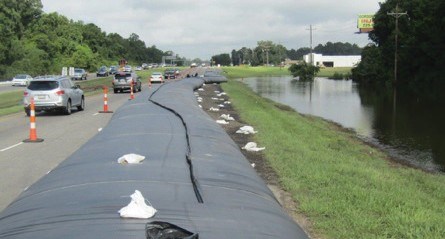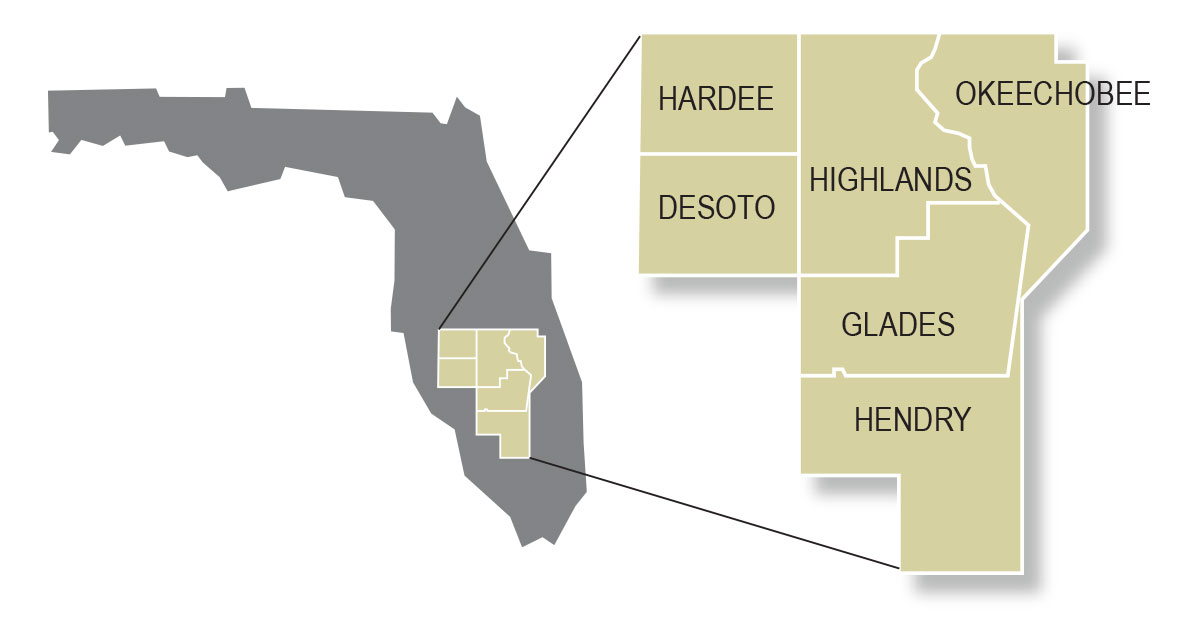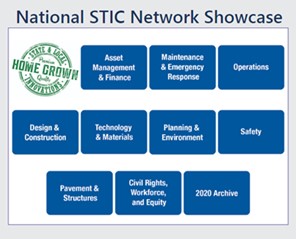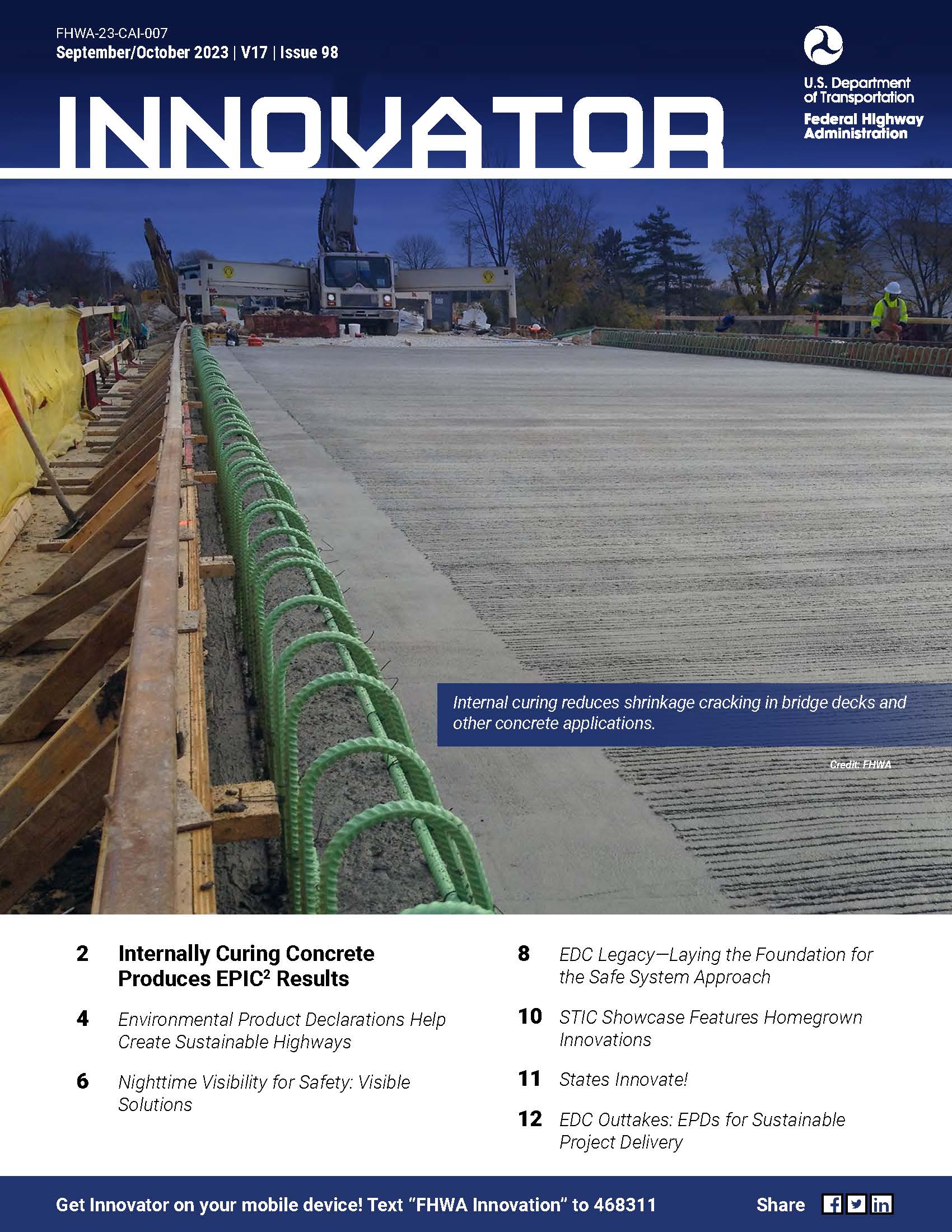September 28, 2023
Innovation of the Month: Weather-Responsive Management Strategies
WRMS efforts help agencies to be better equipped for response and recovery efforts to flooding by leveraging and building data, tools, and agency relationships. This factsheet features several WRMS tools for flood preparation and response and example States which have used them.
In our last issue, we discussed how State DOTs are using Weather-Responsive Management Strategies (WRMS) to respond to severe weather events such as hurricanes. One challenge these DOTs face is flooding. The impacts of flooding events, however, extend far beyond the reach of hurricanes or other tropical storms. These events can occur after any major storm event or seasonally from thawing. During flooding events, protecting and preserving roadway infrastructure from damage and ensuring structural integrity are critical activities for agencies.

Water-filled barriers can protect roadways from flood waters. (Credit: Louisiana DOTD)
One such tool is water-filled barriers. These barriers may be strategically placed along with pumps in advance of or during flood events to help clear water from roadways. With the help of a pump, water-filled barriers may even use the floodwater itself as a means for inflation to help protect infrastructure and maintain mobility during flood events.
Flooding following major rain events in 2019 significantly impacted travel between Baton Rouge and New Orleans. A trip that should take one hour in normal conditions was taking 6-8 hours to bypass flooded roadways and DOTD knew the floodwaters would take weeks to recede. These events prompted DOTD to explore using water barriers to help restore normal travel. DOTD placed water-filled barriers within 24 hours along the edges of US 61 and inflated them with floodwaters. The remaining water was then pumped off the road. DOTD also noted the ability to reuse these barriers as a significant benefit, though the agency recommends cleaning and recertifying barriers after each use due to potential floodwater contamination.
Creating a plan with flood-related weather-responsive management strategies helps agency staff understand the locations and potential impacts of flooding events. In turn, the plan can help determine how to use available resources and tools to effectively protect infrastructure and possibly lives.
To learn more about how WRMS can help your agency prepare for adverse weather events, contact David Johnson, FHWA Office of Operations.
The Heartland TIM Team: Safeguarding Rural Florida Roads
Rural responders share many common challenges, such as access to resources and difficulties in communication. In addition, unique TIM incidents like those involving livestock and agricultural products make clearing these type incidents complicated. In rural areas, local incident response resources are also easily taxed. Adjoining counties often assist one another to meet the challenges of rural TIM.

Highlighted counties form a unique regional TIM team away from urban development. (Credit: Florida DOT)
In Florida, agencies often form traffic incident management (TIM) teams to address common issues and lend mutual support. Florida has a long history of using TIM teams to enhance safe, quick clearance of roadway incidents.
In 2022, the Florida Department of Transportation (FDOT) District One launched the State's 26th TIM team, which operates in a rural six-county area of Southwest Florida dubbed the Florida Heartland, with over 70 participants from its stakeholder disciplines– fire, rescue, law enforcement, towing, and FDOT. This TIM Team operates with no interstate highways but a large amount of agricultural land bordering Lake Okeechobee and the Everglades.
One of the team's primary focuses is to improve the 3 Cs: communication, coordination, and cooperation among incident responders. Areas in Florida with TIM teams often see benefits such as reducing incident-related congestion, improving response and clearance times, preventing secondary crashes, and most importantly improving responder and motorist safety. This is one of the reasons that Florida has a legacy of investing time and resources into supporting urban and suburban TIM teams.
To learn more about TIM teams or other TIM strategies and technologies, contact Paul Jodoin, James Austrich, or Joseph Tebo, FHWA Office of Operations.
Discover Home-Grown Innovations from Around the Country

Are you interested in homegrown innovations being used by your peers in other parts of the country? Check out the National STIC Network Showcase, a component of the EDC-7 Virtual Summit. Registering for the event allows you to access all the content through February 2024. The Showcase features several innovations around pavements.

Learn about the Iowa DOT's Flood Resiliency Analysis Tool, which helps the DOT identify the roads most vulnerable to extreme flood events and prioritize the State's investments to address these vulnerabilities. The metrics and framework used in this tool are designed to be replicated or adapted by other transportation agencies.
Celebrate the ingenuity of your peers and read about these innovations–developed and deployed in-house at transportation agencies nationwide. Additionally, we invite you to watch the one-hour presentations on-demand that feature many of these and other innovations.
New Innovator Now Available!
The September/October issue of Innovator is now available, accessible from yourcomputer, tablet, or mobile phone to optimize your reading experience!
In this issue:
- Internally Curing Concrete Produces EPIC Results
- Environmental Product Declarations Help CreateSustainable Highways
- Nighttime Visibility for Safety: Visible Solutions
- EDC Legacy–Laying the Foundation for the Safe System Approach
- And more...
Comments? Questions? We'd love your feedback! Drop us a line and let us knowwhat you think.
Read past issues and sign up to receive Innovator by email here, or text "FHWA Innovation" to 468311 to get Innovator on your smartphone.
Stay Up to Date on the EDC Innovations That Interest You Most

EDC teams are always on the move! If you blink, you could miss out on important webinars, case studies, tools, videos, and more. To never miss information for the EDC innovations that interest you most, visit the subscription page and select the topics you'd like to receive updates on directly from the teams that coordinate them.
Recent bulletins:
Next-Gen TIM 9/22/23
Local Aid Support (Funding Opportunity) 9/18/23
UAS 9/14/23
Upcoming Events
Global Benchmarking Webinar Series: Improving Pedestrian Safety on Urban Arterials
Part 2: The Movement and Place Framework
October 2, 2023, 2:30-4:00pm ET Details Register
Value Capture Strategies and Asset Recycling
October 18, 2023, 1:00-3:00pm ET Register
Global Benchmarking Webinar Series: Improving Pedestrian Safety on Urban Arterials
Part 3: A Safe System Approach to Road Safety Audits
October 23, 2023, 2:30-4:00pm ET Details Register
About EDC
Every Day Counts, a state-based initiative of the Federal Highway Administration's Center for Accelerating Innovation, works with state, local and private sector partners to encourage the adoption of proven technologies and innovations to shorten and enhance project delivery.
EDC News is published weekly by the FHWA Center for Accelerating Innovation.
Notice: The U.S. Government does not endorse products or manufacturers. Trademarks or manufacturers‘ names appear in this presentation only because they are considered essential to the objective of the presentation. They are included for informational purposes only and are not intended to reflect a preference, approval, or endorsement of any one product or entity.
Disclaimer: The U.S. Government does not endorse products or manufacturers. Trademarks or manufacturers' names appear in this document only because they are considered essential to the objective of the document. They are included for informational purposes only and are not intended to reflect a preference, approval, or endorsement of any one product or entity.
Except for the statutes and regulations cited, the contents of this document do not have the force and effect of law and are not meant to bind the States or the public in any way. This document is intended only to provide information regarding existing requirements under the law or agency policies.
Recommended Citation:
U.S. Department of Transportation, Federal Highway Administration
EDC News; September 28, 2023
Washington, DC



